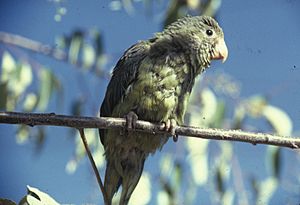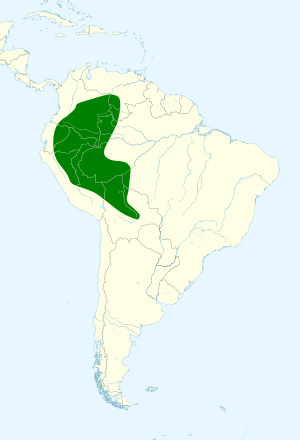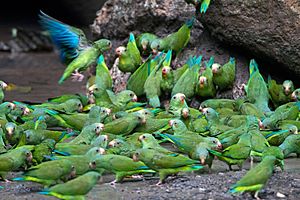Cobalt-winged parakeet facts for kids
Quick facts for kids Cobalt-winged parakeet |
|
|---|---|
 |
|
| Conservation status | |
| Scientific classification | |
| Genus: |
Brotogeris
|
| Species: |
cyanoptera
|
 |
|
| Synonyms | |
|
Brotogeris devillei |
|
The cobalt-winged parakeet (Brotogeris cyanoptera) is a small, colorful bird. It belongs to the parrot family, Psittacidae. You can find these parakeets in South American countries. These include Bolivia, Brazil, Colombia, Ecuador, Guyana, Peru, and Venezuela.
Contents
How Scientists Name Birds
Scientists study how living things are related. This helps them group animals and give them names. The cobalt-winged parakeet was first described in 1870. A scientist named August von Pelzeln gave it its first scientific name. He called it Sittace cyanoptera.
There are three types, or subspecies, of the cobalt-winged parakeet:
- B. c. cyanoptera (Pelzeln, 1870)
- B. c. gustavi Berlepsch, 1889
- B. c. beniensis Gyldenstolpe, 1941
Some scientists once thought B. c. gustavi was its own species. The cobalt-winged parakeet is closely related to the golden-winged parakeet. Scientists call them "sister species."
What They Look Like
The cobalt-winged parakeet is about 18 to 20 centimeters (7 to 8 inches) long. It weighs around 67 grams (2.4 ounces). Most of its body is green. The green is darker on its back.
The main subspecies, B. c. cyanoptera, has a yellowish forehead. It also has an orange chin. Its head and neck feathers have a blue tint. Its flight feathers, used for flying, are blue. The middle tail feathers are blue too, while the others are green. Young birds look similar but are a bit duller.
Other subspecies have slight differences. B. c. gustavi has less blue on its head. It also has a yellow edge on its wing, near the "wrist" joint. B. c. beniensis is lighter green. It has a similar amount of blue on its head and a yellow wing edge like gustavi.
Where They Live
Different types of cobalt-winged parakeets live in different areas:
- B. c. cyanoptera lives in the upper Amazon Basin. This includes parts of Colombia, Venezuela, Guyana, Ecuador, Peru, Bolivia, and Brazil.
- B. c. gustavi lives in the upper Huallaga River valley in northern Peru.
- B. c. beniensis lives in northeastern and central Bolivia.
These parakeets live in many kinds of places. They can be found at the edges of rainforests. They also live inside rainforests, in forests that are growing back, and in savannas. They usually live below 1,000 meters (3,300 feet) in elevation. Sometimes they are seen as high as 1,350 meters (4,400 feet).
How They Behave
Moving Around
Cobalt-winged parakeets usually stay in one area. They might move to different elevations during certain seasons.
What They Eat
Scientists don't know a lot about what these parakeets eat. They have been seen eating flowers and fruits. They also eat special soil that has minerals.
Raising Young
The breeding season for these parakeets is not fully known. In the western part of their home range, it seems to be in June and July. They build their nests inside holes in trees. In captivity, a pair might lay about five eggs. These eggs hatch in about 24 days.
Their Calls
The cobalt-winged parakeet makes high-pitched calls. These sound like "klee" or "chree." They also make a fast chattering sound like "chichichichichi." When many parakeets are together, they call at the same time. This creates a loud, shrill chattering noise.
Their Status
The IUCN (International Union for Conservation of Nature) checks on animal populations. They have listed the cobalt-winged parakeet as "Least Concern." This means they are not currently in danger of disappearing. They live in a very large area. Their total number is unknown, but it seems to be stable. There are no big threats to them right now. They are common in their natural homes. They are not often kept as pets.
See also
 In Spanish: Catita aliazul para niños
In Spanish: Catita aliazul para niños



